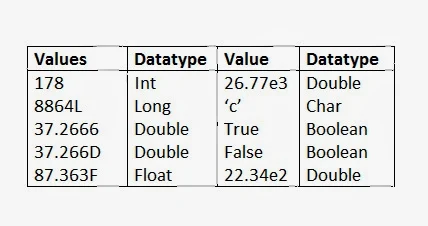Java programming have some more data types for storage of single character and even true/false values. These data types are called Character and Boolean in programming language.
The Unicode character representation code can represent nearly all languages of world such as Hindi, English, German, French, Chinese, and Japanese etc. And because of Unicode character, size of char data type of Java is 16 bits i.e., 2 bytes in contrast to 1 byte characters of other programming languages that support ASCII.
In a Java program, the words true and false always mean these Boolean values. The data type Boolean is named after a nineteenth century mathematics- George Boole, who discovered that a great many things can be done with true/false value. A special branch of algebra Boolean algebra, is based on Boolean values.
Following tables lists examples of various data items of different data types. Here are some examples of literal values of various primitive types:
Character Type
The character data type (char) data type of Java is used to store characters. A character in Java can represent all ASCII (American standard Code for Information Interchange) as well as Unicode characters.The Unicode character representation code can represent nearly all languages of world such as Hindi, English, German, French, Chinese, and Japanese etc. And because of Unicode character, size of char data type of Java is 16 bits i.e., 2 bytes in contrast to 1 byte characters of other programming languages that support ASCII.
- Type: Char (Single Character)
- Size: 16bits (2 bytes)
- Range: 0 to 65536
Boolean Type
Another type of the primitive data type is Boolean. A Boolean value can have one of two values: true or false. So this data type is used to store such type of values.In a Java program, the words true and false always mean these Boolean values. The data type Boolean is named after a nineteenth century mathematics- George Boole, who discovered that a great many things can be done with true/false value. A special branch of algebra Boolean algebra, is based on Boolean values.
- Type: Boolean (Logical values)
- Size: reserve 8 bits uses 1 bit
- Range: true or false
Following tables lists examples of various data items of different data types. Here are some examples of literal values of various primitive types:

